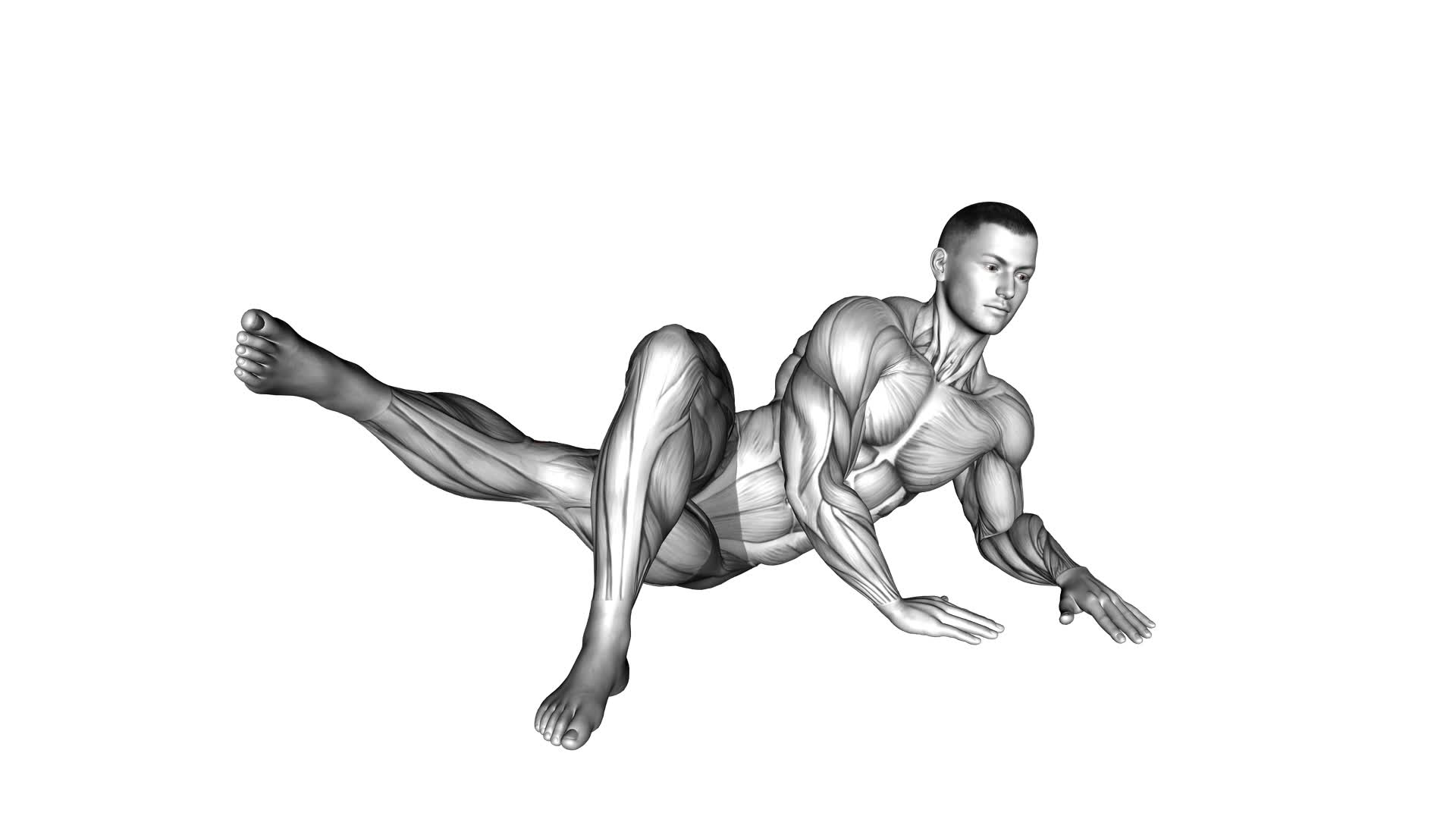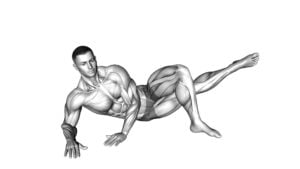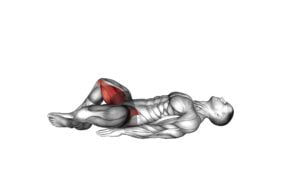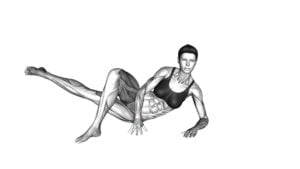Side Lying Hip Adduction (left) (male) – Video Exercise Guide & Tips

Are you looking to strengthen your hip muscles and improve your overall lower body stability? Look no further than the Side Lying Hip Adduction exercise!
Watch This Exercise Video
In this video exercise guide, we'll show you the proper form and technique to effectively target your left hip. With easy-to-follow instructions and helpful tips, you'll be on your way to achieving stronger hips in no time.
So grab a mat, press play, and let's get started!
Key Takeaways
- Side lying hip adduction can improve stability, balance, and athletic performance.
- It can help alleviate lower back pain and prevent injuries.
- There are various exercise variations and alternatives to target different muscle groups.
- Proper form and technique, as well as engaging the core and maintaining proper alignment, are essential for maximizing the benefits and minimizing the risk of injury.
Benefits of Side Lying Hip Adduction
To maximize the effectiveness of your side lying hip adduction exercise, it's important to understand the benefits that this movement provides. Strengthening your hip adductors offers a range of advantages for your overall fitness and functionality. One of the main benefits is improved stability and balance, as strong hip adductors help to support your body's alignment and prevent injuries. By targeting these muscles, you can also enhance your athletic performance in activities such as running, jumping, and lateral movements. Additionally, strengthening your hip adductors can help alleviate lower back pain by improving the stability of your pelvis and reducing strain on your spine.
There are variations and alternatives to the side lying hip adduction exercise that you can incorporate into your routine to further challenge your muscles and avoid plateaus. One variation is using a resistance band around your thighs to add more resistance and intensity to the movement. Another alternative is performing the exercise on a stability ball, which engages your core muscles as well. You can also try standing cable hip adductions or using a hip adduction machine at the gym for a different stimulus. Mixing up your exercises can prevent boredom and keep your muscles guessing, leading to better results over time.
Equipment Needed for the Exercise
To perform the side lying hip adduction exercise, you'll need a few pieces of equipment. The first item you'll need is a mat or a comfortable surface to lie on. This will provide cushioning and support for your body during the exercise. Additionally, you'll need a resistance band or a cable machine with ankle straps. These will be used to provide resistance as you perform the hip adduction movement. It's recommended to choose a resistance band or cable machine that allows for adjustable resistance levels so that you can progress as you get stronger.
When selecting a resistance band or cable machine, it's important to choose one that's appropriate for your fitness level and goals. If you're a beginner, start with a lighter resistance band or lower weight on the cable machine and gradually increase as you become more comfortable and confident with the exercise.
Injury prevention techniques should also be considered when performing the side lying hip adduction exercise. It's important to maintain proper form throughout the movement to avoid placing unnecessary stress on the hips and lower back. Engaging the core muscles and keeping the spine neutral can help protect against injuries. It's also important to start with a light resistance and gradually increase as your muscles adapt and get stronger. Listening to your body and avoiding any movements that cause pain or discomfort is crucial for injury prevention.
Proper Form and Technique
Maintain proper form and technique during the side lying hip adduction exercise to effectively target and strengthen your hip muscles. Proper form not only ensures that you get the most out of the exercise but also helps prevent injury. Here are some benefits of maintaining proper form and common mistakes to avoid:
- Benefits of proper form:
- Increased muscle activation: Maintaining proper form allows you to specifically target and engage the hip muscles, maximizing the effectiveness of the exercise.
- Improved stability: Proper form helps improve your balance and stability, reducing the risk of falls or other injuries.
- Enhanced range of motion: By performing the exercise with correct technique, you can increase your hip joint's range of motion, leading to improved flexibility and overall movement.
- Common mistakes to avoid:
- Using momentum: Avoid swinging your leg or using momentum to lift it. This takes away from the targeted muscle engagement and reduces the effectiveness of the exercise.
- Not lifting the leg high enough: Ensure that your leg is lifted to an appropriate height, ideally parallel to the floor, to effectively engage the hip muscles.
- Allowing the top hip to roll forward or backward: Keep the top hip stacked directly on top of the bottom hip throughout the exercise to maintain proper alignment and maximize muscle activation.
Modifications and Progressions
Now let's explore some ways you can modify and progress the side lying hip adduction exercise to challenge yourself and continue strengthening your hip muscles.
To modify the side lying hip adduction exercise, you can begin by using a lighter resistance band or decreasing the range of motion. This can be helpful if you're a beginner or if you have any limitations or injuries.
Another modification is to perform the exercise in a seated position instead of lying on your side. This can provide additional support and stability.
To progress the side lying hip adduction exercise, you can increase the resistance of the band or use a thicker band. This will make the exercise more challenging and increase the intensity for your hip muscles.
Additionally, you can perform the exercise with your legs straight instead of bent, which will engage different muscles and further enhance the challenge.
Common Mistakes to Avoid
When performing the side lying hip adduction exercise, it's important to be mindful of common mistakes that can hinder your progress and potentially lead to injury.
One common mistake to avoid is improper form, such as allowing your pelvis to rotate or your upper body to twist. This can put unnecessary strain on your joints and limit the effectiveness of the exercise.
Another mistake isn't achieving an adequate range of motion, which can prevent you from fully engaging the targeted muscles and achieving optimal results.
Stay focused on maintaining proper form and maximizing your range of motion to get the most out of this exercise.
Improper Form Dangers
You often risk injury by using improper form during the side lying hip adduction exercise. To ensure your safety and maximize the effectiveness of this exercise, here are three key points to keep in mind:
- Maintain proper alignment: Avoid rolling your hips forward or backward during the movement. Keep your body in a straight line from your head to your feet to prevent strain on your lower back and promote optimal muscle activation.
- Control the movement: Avoid swinging or jerking your leg during the exercise. Instead, focus on slow and controlled movements, engaging the muscles of your inner thigh to adduct your leg towards the midline of your body.
- Use appropriate resistance: Gradually increase the resistance over time to challenge your muscles without compromising your form. Too much resistance can lead to poor control and potential injury, while too little resistance may not provide enough stimulus for muscle growth.
Inadequate Range of Motion
To prevent inadequate range of motion and optimize the effectiveness of the side lying hip adduction exercise, focus on maintaining proper alignment and controlled movements.
Inadequate range of motion can limit the benefits of this exercise, so it's crucial to address this issue. One common mistake to avoid isn't fully engaging the muscles involved in hip adduction. By doing so, you may not be able to achieve the desired range of motion.
Another mistake is rushing through the exercise, rather than taking the time to perform it with proper form and control. This can hinder your progress in improving flexibility and reaping the full benefits of hip adduction exercises.
Remember to always prioritize quality over quantity to maximize your results.
Safety Precautions and Tips
When performing the side lying hip adduction exercise, proper form is of utmost importance. This not only ensures maximum effectiveness but also helps prevent injuries.
To maintain proper form, it's essential to engage the correct muscles and avoid compensating with other body parts.
Additionally, using appropriate equipment, such as a mat or cushion, can provide support and enhance safety during this exercise.
Proper Form Importance
During the Side Lying Hip Adduction (left) exercise, ensure proper form by maintaining a stable position throughout the movement. Proper technique is essential to maximize the benefits of this exercise and minimize the potential risks. Here are three important tips to remember:
- Engage your core: Before starting the movement, make sure to activate your core muscles by pulling your belly button towards your spine. This will provide stability to your body and prevent unnecessary strain on your lower back.
- Control the movement: Slow and controlled movements are key to maintaining proper form. Avoid using momentum or jerky motions, as this can lead to injury. Focus on using your inner thigh muscles to smoothly bring your leg up and down.
- Use appropriate resistance: It's important to choose a resistance level that challenges you without compromising your form. Start with a lighter resistance and gradually increase as you get stronger. Remember, it's better to use less resistance and maintain proper technique than to use too much and risk injury.
Injury Prevention Techniques
To ensure your safety and prevent injuries, it's important to follow certain techniques and precautions during the Side Lying Hip Adduction (left) exercise.
One key aspect of injury prevention is implementing proper warm-up techniques before engaging in any exercise. This helps to prepare the muscles and joints for the upcoming workout, reducing the risk of strain or injury.
Additionally, understanding the common causes of hip injuries can further aid in injury prevention. These can include improper form or technique during exercises, overtraining, or sudden impact or trauma to the hip area.
Equipment Recommendations for Safety
To ensure your safety and prevent injuries, it's important to consider equipment recommendations for the Side Lying Hip Adduction (left) exercise. Here are three items that you should keep in mind:
- Safety equipment: It's recommended to use a mat or a padded surface to provide cushioning and support for your body during the exercise. This will help reduce the risk of discomfort or injury to your hips, knees, and ankles.
- Exercise variations: Depending on your fitness level and comfort, you may choose to use resistance bands or ankle weights to increase the intensity of the exercise. These additional tools can help engage your muscles more effectively and enhance the benefits of the Side Lying Hip Adduction (left) exercise.
- Proper form and technique: Always ensure that you maintain proper alignment and control throughout the exercise. Keep your core engaged, your spine neutral, and perform the movement in a slow and controlled manner. This will help you maximize the effectiveness of the exercise while minimizing the risk of injury.
Frequently Asked Questions
How Often Should I Perform Side Lying Hip Adduction Exercises?
To maximize the benefits of side lying hip adduction exercises, it's important to find the right frequency for your routine. How often should you perform these exercises?
Well, the frequency will depend on your fitness goals and current level of strength. Generally, it's recommended to do these exercises 2-3 times a week.
Consistency is key, so make sure to give your muscles time to rest and recover between sessions.
Can Side Lying Hip Adduction Exercises Help With Strengthening the Glute Muscles?
Side lying hip adduction exercises are an effective way to strengthen your glute muscles. By incorporating variations of this exercise into your routine, you can target different areas of your glutes for a well-rounded workout.
The benefits of side lying hip adduction exercises include improved hip stability, increased hip abduction strength, and enhanced overall lower body strength.
Incorporate these exercises into your fitness regimen to see the positive impact on your glute muscles.
Is It Normal to Feel a Burning Sensation in the Hip During This Exercise?
Feeling a burning sensation in your hip during the side lying hip adduction exercise isn't uncommon. This could be due to the muscles working and getting fatigued.
It's important to listen to your body and not push through excessive pain. Start by doing the exercise at a comfortable frequency and gradually increase as your muscles get stronger.
If the burning sensation persists or becomes severe, it's advisable to consult a healthcare professional for further evaluation.
Can Side Lying Hip Adduction Exercises Help With Improving Hip Flexibility?
Side lying hip adduction exercises can definitely help improve hip flexibility. By targeting the muscles responsible for hip adduction, these exercises can increase your range of motion and enhance overall athletic performance.
To perform them effectively, lie on your side, bend your top knee, and lift your bottom leg toward the ceiling. Keep your core engaged and slowly lower your leg back down.
Remember to breathe and focus on proper form for maximum benefits.
Are There Any Alternative Exercises That Can Target the Same Muscles as Side Lying Hip Adduction?
If you're looking for alternative exercises that target the same muscles as side lying hip adduction, there are a few options you can consider.
Standing cable hip adduction, seated hip adduction machine, and standing hip adduction with resistance band are all effective alternatives.
These exercises work the same muscles, helping to strengthen and tone your hips.
Incorporating these exercises into your routine can provide similar benefits to side lying hip adduction, improving your hip strength and stability.
Conclusion
In conclusion, side lying hip adduction is a highly beneficial exercise for strengthening the hip muscles. By following proper form and technique, using the appropriate equipment, and making necessary modifications and progressions, you can maximize the effectiveness of this exercise.
It's important to be aware of common mistakes and take safety precautions to avoid any potential injuries. Incorporate side lying hip adduction into your fitness routine to improve your hip strength and stability.

Author
Years ago, the spark of my life’s passion ignited in my mind the moment I stepped into the local gym for the first time. The inaugural bead of perspiration, the initial endeavor, the very first surge of endorphins, and a sense of pride that washed over me post-workout marked the beginning of my deep-seated interest in strength sports, fitness, and sports nutrition. This very curiosity blossomed rapidly into a profound fascination, propelling me to earn a Master’s degree in Physical Education from the Academy of Physical Education in Krakow, followed by a Sports Manager diploma from the Jagiellonian University. My journey of growth led me to gain more specialized qualifications, such as being a certified personal trainer with a focus on sports dietetics, a lifeguard, and an instructor for wellness and corrective gymnastics. Theoretical knowledge paired seamlessly with practical experience, reinforcing my belief that the transformation of individuals under my guidance was also a reflection of my personal growth. This belief holds true even today. Each day, I strive to push the boundaries and explore new realms. These realms gently elevate me to greater heights. The unique combination of passion for my field and the continuous quest for growth fuels my drive to break new ground.







